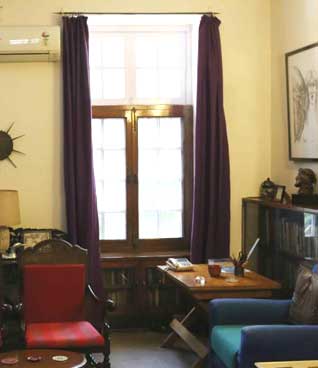People
The Empty Chair:
Inside Khushwant Singh’s Apartment,
On His 3rd Death Anniversary
MAYANK AUSTEN SOOFI
This is where he died exactly three years ago.
We are at E-49, Khushwant Singh’s red-brick apartment at the colonial-era Sujan Singh Park in central Delhi. Privileged members of Delhi’s high society used to plot and manoeuvre to get an invite to his drawing room.
The author of classics such as ‘Train to Pakistan‘, ‘Delhi: A Novel’ and the two-volume ‘A History of the Sikhs’ had lived up to a ripe old age of 99. Khushwant Singh also edited ‘The Hindustan Times‘. His drawing room was one of the most sought-after places in the Capital.
Every evening, he gave audience to friends, ministers, intellectuals, industrialists, authors, and admirers, especially if these admirers happened to be visiting Pakistanis. The meetings, even with intimates, were always arranged by appointment.
The board outside the apartment door famously said: ‘Please do not ring the bell unless you are expected’.
The board is still there.
It is the first time that an outsider is stepping inside the home of one of Delhi’s most iconic authors. We had requested Khushwant Singh’s daughter to grant us a visit to the famous address.
The reclusive Mala Kaur Dayal, who lives with her daughter in an apartment just across the corridor, agreed to let us in on the condition that she would not be photographed.
Escorting us into her father’s drawing room, she points to the familiar chair by the fireside where Khushwant Singh always sat.
Mala confesses that she had only recently started sitting, hesitantly, on this chair.
The bookshelf beside the chair used to be stacked with black hardbounds of Collier’s Encyclopedia. But those books are no longer to be seen.
It turns out that Mala’s daughter, Naina, who teaches ancient Indian history in Delhi University’s St Stephen’s College, shuffled around a few books and pictures after her grandfather passed away. She wanted to bring the place back to her late grandmother’s taste.
Naina’s additions in the drawing room include a framed poem by novelist Vikram Seth (the first alphabet of each line joins to make Khushwant Singh’s name), a calligraphy gift from historian Romila Thapar and Khushwant Singh’s own illustrated portrait that adorns the cover of his book ‘Delhi through the Seasons‘.
Some photographs have remained in their original place, such as the old black-and-white picture of Khushwant Singh and his wife, Kawal Kaur, posing for the camera with their closest friends Manzoor Qadir and his wife Asghari (Qadir and Khushwant had started their law practices together in pre-Partition Lahore).
The other picture is of daughter, Mala, with her husband, the late publisher Ravi Dayal.
One decades-old family portrait also shows Simba, the dog.
The wooden shelves have thousands of books, and the top is stacked with bound volumes of ‘The Illustrated Weekly of India‘, a now-extinct magazine that Khushwant Singh had edited during the 1970s.
The drawing room faces a small dining table with four chairs. The last meal that Khushwant Singh had was orange juice and a buttered toast -- his longtime cook, Chandan Singh, had told us on the day of his death.
The cook was preparing broccoli soup for lunch when Khushwant Singh breathed his last.
In the bedroom, the curtains are painted with green butterflies. He shared the room with his wife, but after she grew ill and needed a medical attendant, he had to leave for the small study next door.
That book-lined room has a single narrow bed. Here Khushwant Singh used to sleep during his final years. The wall behind the bed’s headboard has a framed sketch of the Darbar Sahib in Amritsar.
These days granddaughter Naina often works in this room.
There years ago on this day, after the news of Khushwant Singh’s departure spread through the city, this silent apartment started to mill with people, including the then Prime Minister.
They all had gathered to pay last respects to the author. Friends and admirers continued to visit the home for the next few weeks. It was during those chaotic days - Khushwant Singh’s granddaughter assumes - that his walking stick went missing.
Perhaps that mysterious disappearance must had been the transgression of a Khushwant Singh fan.
[Courtesy: Hindustan Times. Edited for sikhchic.com]
March 21, 2017
Conversation about this article
1: Sangat Sinh (Kuala Lumper, Malaysia), March 21, 2017, 9:35 PM.
“As ordained, all must go, be they sages or humble servants” [GGS:740]. Although Khushwant Singh lived in a coveted high-end place like Sujan Singh Park but part of him always lived in Hadali, Punjab, a humble village now in Pakistan. Thus his special affinity with Pakistan with such kith and kin like the Fakir brothers and his extended family of Mansoor Qadir and his half-hearted law practice with him, thus a befitting home-coming requiem. On his 99th birthday the most lovable and humanist in the person of the President of India, A P J Kalam himself went to visit him at home to wish him on his birthday. Such was the man Khuswant Singh.
2: Arjan Singh (USA), March 23, 2017, 12:33 AM.
#1 S. Sangat Singh ji: I really agree with your comment. S. Khushwant Singh never lost touch with his roots.




